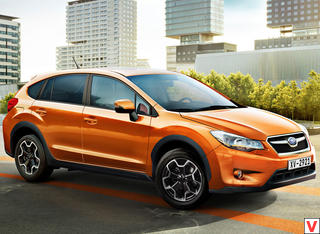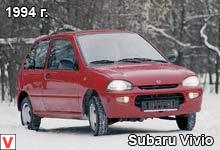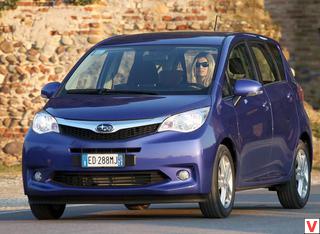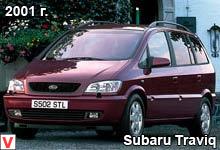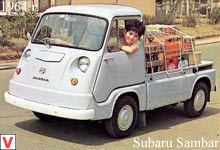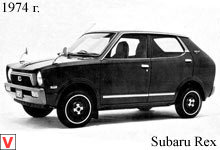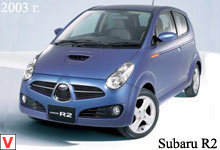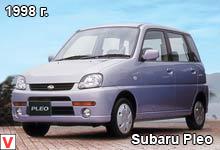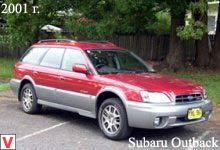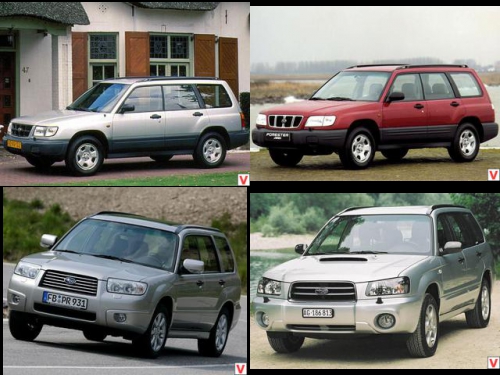
In the mid-90s, Subaru decided not to lag behind its competitors and win its share of the market for “parquet” off-road vehicles, which at that time became very popular in the world. Production of the Subaru Forester (in translation - “forester”) began in December 1996 at the Japanese plant of the company. The European car debut took place in September 1997. Forester is a cross between a small SUV and a spacious wagon, equipped with a full-fledged system of permanent all-wheel drive and has a simple but fairly successful appearance.
The model combines the best qualities of a classic SUV. High seating and a comfortable lounge, which can not offer a sedan. Patency inaccessible wagon. And most importantly - comfort and control inaccessible to off-road vehicles. In general, the Forester has balanced qualities that make it a unique car. Under the hood of the Subaru Forester are only gasoline boxer engines. Compared with standard in-line or V-shaped units, these motors are more compact and make it possible to reduce the center of gravity of the car (this has the best effect on handling).
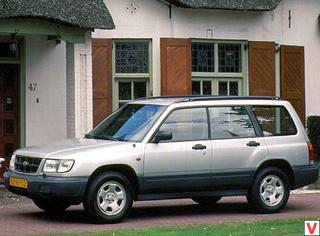
Initially, the Forester was equipped with a 2-liter petrol engine producing 115 hp. In 1998, a conceptually new turbocharged engine with a capacity of 175 hp appeared under the hood. There are two types of gearboxes to choose from: a five-speed manual and an automatic four-speed gearbox. In addition to boxing engines, another feature of the Subaru Forester can be considered an all-wheel drive system, recognized as one of the best in the world. And not only in its effectiveness, but also in reliability. Viscous coupling center differential in the slip of one of the wheels redistributes the moment to another axis.
In many instances, a rear limited-slip differential is installed, there is a reduction gear in the mechanical transmission, and the clearance is 190 mm. In 2000, underwent restyling. Ina view received bumpers and front facing, front light units changed, turn indicators became transparent. In 2002, the second-generation Forester was introduced at the Geneva Motor Show. Dimensions are almost the same as the previous model. The focus of this car was on maneuverability and performance characteristics, security systems that meet the highest international requirements, comfort in use, as well as improved design.

The “second” Forester lost its aggressive appearance, the lines of the car body became much smoother. The headlights of the new design give a more expressive look to the front of the car. The changes also affected the rear part: the weak rear lighting and the thick bumper disappeared, and they were replaced by powerful triangular lights and an enlarged rear window, providing a better view of the road. The bumpers are made in such a way that they do not deform at all at a speed of up to 10 km / h. The biggest changes were in the interior of Forester. Front seats feature extra lateral support. The adjustment range of the driver's seat allows you to adjust it to the driver of any height.
Trunk volume can easily be doubled by folding the rear seats. Great attention was paid to the protection of passengers. The size of the wipers has increased, which now allows you to clean a large area of the windshield. The rear wiper even cleans and a brake light so that it can be clearly seen in bad weather.

The front seats are equipped with stiffer head restraints, and each seat is equipped with a three-point seat belt. However, the most fundamental changes affected the chassis of the Forester. The second generation is built on the Impreza platform, which will provide a softer ride, smooth corners and better grip. New hydroformed front subframe added stiffness chassis. Subaru has achieved a reduction in the weight of each of the Forester models, thanks to the manufacture of the roof, bonnet and bumpers of aluminum alloy - by more than 30 kg. The basic version is equipped with a 2-liter standard engine producing 125 hp.
For those who like “hotter”, a 2.5-liter engine with a power of 210 hp and a 4-speed automatic or 5-speed manual gearbox are offered. In September 2005, the Subaru Forester 2006 was introduced at the Frankfurt International Motor Show. The exterior of the new Forester has undergone a number of positive changes and improvements. In addition to a completely new bumper, grille, increased fog lights and more expressive front and rear lights, the company's designers have given a new look to the hood and side wings.
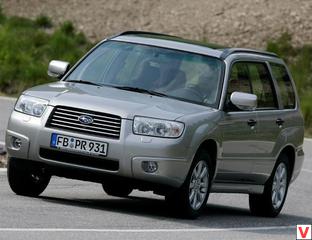
At the same time, they increased the internal width of the passenger compartment, the legroom of the passengers sitting behind them, improved all-round visibility, aerodynamic qualities and fuel economy. The dashboard of a large size clearly gives all the necessary information. Designed for maximum comfort, the driver's seat has developed lateral support. On the technical side, the Subaru Forester 2006 has also changed significantly. The power that the 2-liter version of the Subaru Forester 2.0X now gives out has grown noticeably from 125 hp. On February 17, 2006, the millionth Subaru Forester car rolled off the assembly line.
The success of this model, according to experts, was ensured by a successful set of consumer qualities. In addition, this model has always been equipped with powerful engines and has excellent handling. Today, this Japanese car is still in steady demand all over the world. By the tenth anniversary of the model, Subaru has released the Forester 10th Anniversary designed on the basis of a complete set 2.0X with an automatic transmission. The car is equipped with custom-made cast 17-inch wheels made of aluminum, driver's seat with electric drive, MOMO steering wheel with leather braided, tinted windows impervious to ultraviolet rays, halogen lamps, etc.
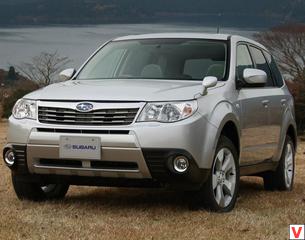
In 2007, Subaru introduced the third generation of this car. The 2008 model year's Forester has become taller, wider, longer than its predecessors by 45, 65 and 205 mm, respectively. The increase in ground clearance to 225 mm provided the car with even greater throughput.
Wheelbase increased by 91 mm. So the space inside was added. In the interior decoration used only high quality materials. The number of pockets, coasters and various containers is not countable.

Each control is positioned so as to best link the driver with the car and to establish full control over the road. In terms of cargo volume, the Forester is one of the leaders in its segment: 0.88 m³ with the rear seat raised, 1.95 m³ with the vehicle folded. The developers paid special attention to safety. The car retained the company's symmetrical permanent all-wheel drive Symmetrical All-Wheel Drive, and also received the Vehicle Dynamic Control dynamic stability control system and the EBD brake force distribution system. Absolutely all versions have 6 airbags, including side “curtains” and a tilt sensor.
Forester 2008 is equipped with special head restraints that prevent injury to a person’s neck, and a safety steering wheel. Disc brakes on all wheels, ABS and Brake Assist. Even modifications with a manual transmission can be equipped with the Incline Start Assist system, which prevents the car from rolling down when starting up the hill. Special attention is given to the fact that Forester 2008 received the highest score on the results of the latest NCAP crash tests for protecting the driver and passengers in frontal and side collisions. The car was equipped with modernized horizontally opposed engines of 2.0 l., 2.5 l / 173 hp.
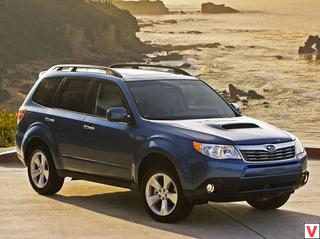
and 2.5 l / 224 hp turbo, differing from previous high torque in the zone of low and medium speed. The fuel efficiency has been improved and the level of toxic emissions in exhaust gases has been reduced. For all versions there are two transmissions to choose from - 5-speed manual and 4-speed automatic.
In the Russian market, the car is offered in several trim levels, the most modest version is 2.0 X, and the most sophisticated 2.5 XT. In 2010, the Forester updated. Continuing the tradition of predecessors, the car went to a new level. According to the manufacturer, the list of updates included in the modernization program consists of a dozen positions. Externally, the Japanese crossover has changed only in strokes, but has become more sporty. The design of the frontal part of the car has changed - the decorative front grill and the shape of the front optical groups have been redrawn. Rear-view mirrors have changed shape to suit aerodynamics and get built-in turn signal lights on LEDs.
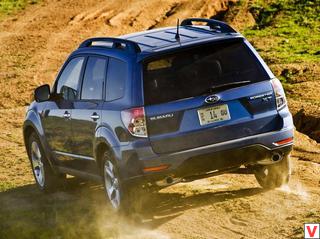
Changed the pattern of seventeen-inch alloy wheels. In the back of the car appeared spoiler, improving the aerodynamic characteristics of the car. In the palette of colors added a couple of new shades of the body. Inside, the novelty is also a bit: the new luminescent scales of the instruments with an integrated display, duplicating the readings of the onboard computer, dual-zone climate control, an updated audio system with a 4.3-inch color display and a rear-view camera. All these things, being quite stylishly executed, fairly ennoble the interior space, not to mention the fact that they themselves are very useful and functional.
The interior has been replenished with new materials for trimming the dashboard and doors, as well as new fabrics for upholstery. True, it is worth clarifying that the two-liter versions did not get separate climate control. They do not have a new instrument panel with fluorescent lighting. And the readings of the trip computer, as before, are read only from a narrow display controller above the radio tape recorder. However, subarovtsam has something to boast, and in addition to the "scenery". The main objects of the modernization of the crossover engines were.
The developers had the task to ensure smooth acceleration in the whole rev range, as well as to make atmospheric engines more economical and environmentally friendly. In technical terms, it looks like this. In order to increase the torque at low and medium engine speeds, the piston stroke was made longer (from 75 mm to 90 mm). Developed a new compact combustion chamber and introduced a chain timing drive with a small asterisk. And also radically changed the installation procedure of the piston and connecting rod. The system of service holes and sequential installation of pistons is a thing of the past; now they put split rods at an angle.
In addition, reducing the angle between the intake and exhaust valves, positioned camshafts closer to each other; optimized the intake system so as to supply as much air as possible and mix it better with the fuel; introduced separate cooling circuits for the head and the block; reduced the friction of moving parts. As a result, both atmospheric boxer engine volume of 2.0 and 2. Modified suspension. The damping forces of the front and rear shock absorbers have been optimized, including through the introduction of a new valve on the rear, providing an accelerated damping response.
The result was a slight increase in ride comfort with full preservation of traditional subarovsky advantages - sharpness and accuracy of control. The basic equipment is equipped with all-wheel drive, a set of various airbags (side, curtain and front), as well as a VDC system that supports directional stability. In November 2012, the 4th generation Subaru Forester was presented at the Tokyo Motor Show. No revolutionary changes in the appearance of the crossover has happened - in terms of design, the novelty resembles the previous generation.
The front part of the car body was created in the corporate style of the company: large block headlights received stylish strips of LEDs, they are successfully combined with an updated false radiator grille and relief wheel arches. Subaru Forester 2013 added in size: the length is 4595 mm, the height has increased to 1735 mm, and the width is equal to 1795 mm. The wheelbase has grown to the mark of 2640 mm. Ground clearance - 220 mm. Due to the increased overall dimensions, door apertures are increased, which will have a positive effect on the convenience of boarding and disembarking passengers.
The car got bigger, but not heavy: due to the use of high-strength steels curb weight remained at the same level (one and a half tons). There are also innovations that are apparently not visible, but this is no less relevant. According to the developers, the body of the Subaru Forester 2013 became more rigid, which made it possible to significantly reduce the level of vibrations when driving off-road. The interior of the Forester 2013 model year has not changed significantly. Everything is still concise, functional and aesthetic. The interior design is largely borrowed from the Subaru XV model. This is especially true of the dashboard.
It looks stylish and harmonious, the function of each control is clear at first glance and easy to use. The top of the new instrument panel is trimmed with soft plastic, the door armrests are also softer. The turn signals have a “short” mode, the “wipers” zone on the windshield is still heated, and the washer is now turned on by the usual pressing of the “self” flag, and not by a button on the end. The steering wheel of the Subaru Forester 2013 is equipped with buttons that allow you to control multimedia and other systems. The “blades” of gear shift were shortened and transferred from the steering column to the steering wheel itself, so that they were at hand.
Heated seat buttons are now on the dashboard, and not pushed behind the “handbrake”, where it was inconvenient to get close to them. The driver’s landing became 36 mm higher (plus a comfortable back was higher and the adjustment range in length and height became wider). They also worked on improving visibility: side mirrors became larger and shifted back to reduce blind spots, triangular windows appeared in the doors, as on many minivans. In general, the salon has retained the best traditions of quality and ergonomics of the Forester model, while it has become much more modern. Borrowing the interior of the XV went to his advantage.
side mirrors have become larger and shifted back to reduce blind spots, triangular windows appeared in the doors, as on many minivans. In general, the salon has retained the best traditions of quality and ergonomics of the Forester model, while it has become much more modern. Borrowing the interior of the XV went to his advantage. side mirrors have become larger and shifted back to reduce blind spots, triangular windows appeared in the doors, as on many minivans. In general, the salon has retained the best traditions of quality and ergonomics of the Forester model, while it has become much more modern.
Borrowing the interior of the XV went to his advantage. The luggage compartment volume has grown to 505 liters. In the trunk there were pockets, cargo hooks, a socket and buttons for folding the back of the sofa.
By the way, the volume of the trunk with the rear seats folded down increases to 1577 liters. In addition, the tailgate versions 2.5 and 2.0XT now have a servo with position memory in height. The line of power units has also undergone modernization. Four-wheel drive Subaru Forester 2013 is offered with three types of boxer gasoline engines: 2 l (150 hp), 2.5 l (171 hp) and 2 l turbo (240 hp). Depending on the configuration, the car is equipped with a manual gearbox or a brand-name variator, the Lineatronic.
The updated base 2-liter gasoline engine still develops 150 hp. and 198 Nm of the moment, but the changes in the engine weight and all of them are aimed at reducing fuel consumption. The engine received a system of variable valve timing, new timing chains with reduced friction, lightweight connecting rods and pistons, as well as an oil pump and a generator of variable performance. In order to burn better and cleaner, the shapes of the combustion chambers and the bottom of the pistons were changed, plus the intake systems (air dampers installed) and exhaust were redone. And now there is less vibration: engines with variators were installed on the hydraulic supports.
With the new 6-speed "mechanics" (it replaced the old 5-speed box), it takes 10.6 s to accelerate to 100 km / h - 0.1 s less than before, and the car with the Lineatronic variator spends 11.8 on this exercise c - 0.6 c less. 2.5-liter engine and 171 hp inherited from the previous generation, but now it is available only with the CVT. The fourth generation turbo version is different. Instead of the previous 2.5-liter EJ25 engine, there is a new 2-liter FA20 DIT engine. Due to direct injection, more responsive twin-turbine and increased to 10.6 compression ratio, 240 hp were removed from it.
But the most important thing is 350 Nm of torque, which is even slightly higher than the previous 2.5-liter turbo engine in the top versions XT (230 hp) and S-Edition (263 power). Externally, a car with a turbo engine can be recognized by a bumper with side air ducts. The new all-wheel drive system “X-MODE” was developed for driving on rough or slippery roads and provides excellent traction on all types of roads. The engine, transmission and all-wheel drive system VDC are controlled together. The system recognizes various road conditions. In crash tests, Euro NCAP Forester 2013 earned 5 stars.
